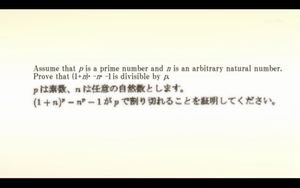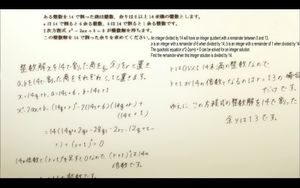User talk:Prima: Difference between revisions
(→entropy post from general: new section) |
(simplyfied first solution, second solution) |
||
| Line 20: | Line 20: | ||
x = r mod 14. | x = r mod 14. | ||
x^2 - 2ax + b = 0 is equivalent | x^2 - 2ax + b = 0 is equivalent to | ||
x | x^2 - 12x + 1 = 0 mod 14 | ||
x | x(x - 12) = -1 mod 14 | ||
x | -1 has no proper divisors modulo 14, thus factors x and x-12 must correspond to either 1 or -1 mod 14. | ||
If x = 1 mod 14, then x-12 = 3 mod 14: false. If x = -1 mod 14, then x - 12 = 1 mod 14: true. | |||
Therefore, x = -1 mod 14 = 13 mod 14, i.e., the remainder r of x is 13. | |||
'''Second Solution''' | |||
Homura used in Episode 1 a basic approach with usual integer arithmetic. | |||
Let x = 14q + r, a = 14s + 6, b = 14t + 1. | |||
Substitute into x^2 - 2ax + b = 0 to get after some calculations | |||
x^2 - 2ax + b = 14c + (r+1)^2 = 0 with c = 14q^2 + 2q - 28qs - 2rs - 12q + t - r | |||
14 divides 14c and 0, hence it also divides (r+1)^2. This implies that r+1 is divisible by 14. | |||
The question asks for a remainder r between 0 and 13, so we obtain r = 13. | |||
See also: http://green-oval.net/cgi-board.pl/a/thread/44824340 | |||
==Episode Nine== | ==Episode Nine== | ||
Revision as of 16:19, 9 March 2011
The following are Mathematics problems that appeared in episodes of Madoka Magica and their solutions.
Episode One
The question reads:
Any integer divided by 14 will have a remainder between 0 and 13. Given a is has remainder of 6 and b has remainder of 1 when divided by 14, what is the remainder of x when divided by 14, given x is an integer solution to x^2-2ax+b=0?
Solution:
This problem can be solved simply with modular arithmetrics: a = 6 mod 14; b = 1 mod 14; x = r mod 14.
x^2 - 2ax + b = 0 is equivalent to
x^2 - 12x + 1 = 0 mod 14
x(x - 12) = -1 mod 14
-1 has no proper divisors modulo 14, thus factors x and x-12 must correspond to either 1 or -1 mod 14.
If x = 1 mod 14, then x-12 = 3 mod 14: false. If x = -1 mod 14, then x - 12 = 1 mod 14: true.
Therefore, x = -1 mod 14 = 13 mod 14, i.e., the remainder r of x is 13.
Second Solution
Homura used in Episode 1 a basic approach with usual integer arithmetic.
Let x = 14q + r, a = 14s + 6, b = 14t + 1.
Substitute into x^2 - 2ax + b = 0 to get after some calculations
x^2 - 2ax + b = 14c + (r+1)^2 = 0 with c = 14q^2 + 2q - 28qs - 2rs - 12q + t - r
14 divides 14c and 0, hence it also divides (r+1)^2. This implies that r+1 is divisible by 14.
The question asks for a remainder r between 0 and 13, so we obtain r = 13.
See also: http://green-oval.net/cgi-board.pl/a/thread/44824340
Episode Nine
This advanced Algebra problem previously appeared in the 2003 Tokyo entrance exam:
The text reads:
A number sequence {F(n)} that can be defined as F(1) = 1, F(2) = 1, F(n+2) = F(n) + F(n+1) (where n is any natural number) is called the Fibonacci sequence and its general solution is given by,
Answer the following questions by using this fact if needed:
Define a sequence of natural numbers X(n) (where n is any natural number), in which each digit is either 0 or 1, set by the following rules:
(i) X(1) = 1
(ii) We define X(n+1) as a natural number, which can be gotten by replacing the digits of X(n) with 1 if the digit is 0, and with 10 if the digit is 1.
For example, X(1) = 1, X(2) = 10, X(3) = 101, X(4) = 10110, X(5) = 10110101, ...
(1) Find A(n), defined as the number of digits of X(n)?
(2) Find B(n),defined as the numbers of times '01' appears in X(n)? For example, B(1) = 0, B(2) = 0, B(3) = 1, B(4) = 1, B(5) = 3,...
Solution
Part (1)
Let A(n) equal to the number of digits in X(n), which consists solely of 1s and 0s. Let's suppose x(n) is the number of 0s in X(n) at n iteration (poor choice of variable by the student). Let's suppose y(n) is the number of 1s in X(n) at n iteration.
1) Every time a 0 appears, it is replaced with 1 at the next iteration.
2) Every time a 1 appears, it is replaced with 10 at t he next iteration.
Therefore, the number of 0s in the next iteration is equal to the number of 1s previously:
x(n+1)= y(n)
and the number of 1s in the next iteration is equal to the number of 0s AND the numbers of 1s previously:
y(n+1)=x(n)+y(n)
Prove: x(n) is a fibonacci sequence:
i) y(n+1) = x(n) + y(n)
ii) x(n+2) = y(n+1)
iii) x(n+1) = y(n)
complete the substition shows:
x(n+2) = y(n+1) = x(n) + y(n) = x(n) + x(n+1)
x(n+2) = x(n+1) + x(n) ie definition of fibonacci sequence
Since x(n) is a fibonacci sequence, y(n) is also a fibonacci sequence since x(n+1) = y(n). Therefore:
x(n+2)=x(n+1)+x(n)
y(n+2)=y(n+1)+y(n)
x(n+2)+y(n+2)=x(n+1)+y(n+1)+x(n)+y(n)
Recall: A(n)=x(n)+y(n), therefore
A(n+2)=A(n+1)+A(n)
X(1) = 1, X(2) = 10, X(3) = 101, X(4) = 10110, X(5) = 10110101, ...
therefore: A(1) = 1, A(2) = 2, A(3) = 3, A(4) = 5, A(5) = 8,...
Recall fibonacci sequence F(n): 1, 1, 2, 3, 5, 8. Therefore A(n) = F(n+1), or
Part (2)
Let B(n) be the number of times '01' appears in X(n).
Any two digits in X(n) may be 00, 01, 10, 11
the corresponding digits in the next iteration X(n+1) will be
00 -> 11
01 -> 110
10 -> 101
11 -> 1010
Thus, any two digit sequence in X(n) that begins with 1* will contribute to a 01 sequence in the next iteration. In other words, B(n+1) equals y(n), except when unit digit of X(n) is 1, or:
B(n+1) = y(n) - odd(X(n))
y(n) is a fibonacci sequence with starting values: y(1) = 1, y(2) = 1, y(3) = 2 thus y(n) = F(n)
B(n+1) = F(n) - odd(X(n))
B(n) = F(n-1) - odd(X(n-1)), or
- >Will there ever be a Mathematics and Madoka page?
You can make one in the Speculah category (and link it from the Articles page) if you want.
As a side note, I think we should have a science page or something given all the discussion about lolentropy from this week. Maybe make a general page "Madoka and Science" and put all that stuff there in different sections? --Homerun-chan 15:10, 8 March 2011 (UTC)- I am not good with wiki, so if you can make the Natural Sciences and Madoka category and a page out of this mess, I'll be hugely appreciative. Prima 00:27, 9 March 2011 (UTC)
entropy post from general
notes on entropy from general http://www.youtube.com/watch?v=TbRSd2THTUQ 31:00 Entropy explains why sea ...
“Assume Incubators are trying to sustain the entire universe using the misery of little girls. According to data gathered by the Wilkinson Microwave Anisotrophy Probe (WMAP), energy density of the universe comes down to roughly 9.9 x 10^-30 g/cm3, or 0,889767627 joules/km^3. The expansion rate of the universe, again as determined by WMAP observations is roughly 71.9 (km/s)/Mpc, ignoring other studies. The minimum radius of the universe, as determined by cosmic microwave background radiation data, is 12 gigaparsecs. Consequently, the universe gains at least 862800 kilometers of radius per second, which comes down to a volume gain of 1.48656647 × 10^54 kilometers cubed per second.
Thus, in order to maintain the energy density of the universe (admittedly, though, there are better ways to preserve life) 1.32269872 × 10^54 joules is required every second. Let us use high estimates and say that there is one magical girl for every 1,000 people. As of now, there are roughly 6,9 billion living people, so there are 6,900,000 magical girls across the world. Assume that every magical girl defeats a witch every two days, and hands over her Grief Seed to an Incubator for its energy to be collected. This comes down to roughly 40 witches being defeated every second. Therefore, if the energy density of the universe is to be maintained, every Grief Seed needs to have an energy output of at least 3.31249766 × 10^52 joules. What can you do with this sort of energy?
a. Supply the Earth’s energy needs for roughly 8,6 octillion years, a timespan 6,2802117 × 10^17 times the current age of the universe. b. Create 3,68565071 × 10^35 kilograms of any matter (except cheese.) This comes down to about 184027 sun-sized stars, 61 billion Earth-sized planets or a single supermassive black hole with a radius of 547298,036 kilometers, roughly 1,4 times the distance between Earth and the Moon. c. In a single year, enough energy is collected to create roughly 10 galaxies the size of our Milky Way. d. Create a single explosion a few hundred thousand times stronger than any gamma ray burst we’ve observed so far. This would end most, if not all life (at least carbon-based life as we know it) pretty much everywhere from Earth to Andromeda galaxy.”
Personally, the only reason I can muster for this bizzare turn is that the writers want to change the setting. In the previous episodes, QB has become a bit too obviously antagonistic, making him a villain of sorts. But this development changes things, making QB not a villain but an act of god. Something outside human power. So the objective here becomes not “winning,” but rather “surviving”




